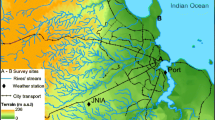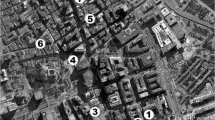Abstract
Religious spaces are an integral part of Indian cities. Unique in their spatiality, they function as socio-cultural hubs drawing users from varied economic and social hierarchies. This study deals with physical and perceptional assessments of micrometeorological conditions in two religious squares namely Hanuman Mandir Square (HMS) and Gurudwara Bangla Sahib Square (GBS) located in New Delhi (28.6° N; 77.2° E), India. The study involved real-time physical measurement of environmental variables such as dry-bulb temperature (Ta, °C), globe temperature (Tg, °C), relative humidity (RH), and air velocity (Va). Variables such as physiological effective temperature (PET), universal thermal comfort index (UTCI), and mean radiant temperature (Tmrt, °C) were computed from measured variables. Concurrent thermal comfort surveys were carried out with 353 respondents in both the squares. The paper describes the thermal characteristics of the studied squares and presents the associated subjective thermal response and preferences of the users. PET was found to correlate well with the subjective responses. The neutral value of PET is found to be 24.7 °C. The neutral PET value of respondents visiting for non-worship purposes was found to be 2.7 °C lesser than those visiting for worship purposes. People visiting the squares for non-worship purpose however were found to be more tolerant of higher PET conditions as compared to others. Factors such as intent of visit, solar exposure, thermal history, and landscape elements were found to have a statistically significant influence on the thermal perception. The paper further summarizes the adaptive opportunities preferred by the users in order to improve thermal comfort in the studied squares. A weighted ranking of adaptive preferences reported by the respondents has also been presented.




Similar content being viewed by others
References
Ahmed KS (2003) Comfort in urban spaces: defining the boundaries of outdoor thermal comfort for the tropical urban environments. Energ Build 35(1):103–110
Ali SB, Patnaik S (2017) Thermal comfort in urban open spaces: objective assessment and subjective perception study in tropical city of Bhopal, India. Urban Clim 0–1 . doi: https://doi.org/10.1016/j.uclim.2017.11.006
Aljawabra F, Nikolopoulou M (2010) Influence of hot arid climate on the use of outdoor urban spaces and thermal comfort: do cultural and social backgrounds matter? Intell Build Int 2:3, 198–217
ASHRAE (2004) ASHRAE Standard, ANSI/ASHRAE Standard 55-2004: thermal environmental conditions for human occupancy. American Society of Heating, Refrigerating, and Air-Conditioning Engineers, Atlanta
ASHRAE, ASHRAE/ANSI Standard 55-2010 (2010) Thermal environmental conditions for human occupancy. American Society of Heating, Refrigerating, and Air-Conditioning Engineers: Atlanta, GA
ASHRAE (2013) ANSI/ASHRAE Standard 55. Thermal Environmental Conditions for Human Occupancy. American Society of Heating, Refrigerating and Air-Conditioning Engineers, Atlanta
Auliciems A (1981) Towards a psycho-physiological model of thermal perception. Int J Biometeorol 25(2):109–122
Broede P (2009) Program for calculating UTCI Temperature (UTCI). u. V. a. 0.002
Chatzidimitriou A, Chrissomallidou N, Yannas S, Sites U (2006) Ground surface materials and microclimates in urban open spaces. 23rd Conf Passiv Low Energy Archit 485–490
Cohen P, Potchter O, Matzarakis A (2013) Human thermal perception of coastal Mediterranean outdoor urban environments. Appl Geogr 37:1–10
Fanger PO (1972) Thermal comfort. McGraw Hill, New York
Gagge AP, Fobelets A, Berglund LG (1986) A standard predictive index of human response to the thermal environment. ASHRAE Trans 92:709–731
Herzog TR (1992) A cognitive analysis of preference for urban spaces. J Environ Psychol 12(3):237–248
Herzog TR, Kaplan S, Kaplan R (1976) The prediction of preference for familiar urban places. Environ Behav 8:627–645
Höppe P (2002) Different aspects of assessing indoor and outdoor thermal comfort. Energy and Buildings 34:661–665
Houghten FC, Yaglou C (1923) Determining lines of equal comfort. ASHVE Trans 29(10):163–176
Humphreys M (1970) A simple theoretical derivation of thermal comfort conditions. J Inst Heat Ven Eng 38:95–98
Indraganti M (2010) Adaptive use of natural ventilation for thermal comfort in Indian apartments. Build Environ 45:1490–1507. https://doi.org/10.1016/j.buildenv.2009.12.013
Indraganti M, Ooka R, Rijal HB (2015) Thermal comfort in offices in India: Behavioral adaptation and the effect of age and gender. Energy and Buildings 103:284–295
Indraganti M, Lee J, Zhang H, Arens E (2016) Why is the Indian Sari an all-weather gear? Clothing insulation of Sari, Salwar-Kurti, Pancha, Lungi, and Dhoti. UC Berkeley: Center for the Built Environment. Retrieved from https://escholarship.org/uc/item/0080t60q
ISO 8996 (2004) Ergonomics of the thermal environment— Determination of metabolic rate. International Organization for Standardization, Geneva
ISO 7730 (2005) Ergonomics of the thermal environment-analytical determination and interpretation of thermal comfort using calculation of the PMV and PPD indices and local thermal comfort criteria. International Standards Organization, Geneva
Johansson E, Yahia MW, Arroyo I et al (2018) Outdoor thermal comfort in public space in warm-humid Guayaquil, Ecuador. Int J Biometeorol 62:387
Kántor N, Égerházi L, Unger J (2012) Subjective estimation of thermal environment in recreational urban spaces—part 1: investigations in Szeged, Hungary. Int J Biometeorol 56:1075–1088
Klemm W, Heusinkveld BG, Lenzholzer S, Jacobs MM, Van Hove B (2015) Psychological and physical impact of urban green spaces on outdoor thermal comfort during summertime in The Netherlands. Build Environ 83:120–128
Knez I, Thorsson S (2006) Influences of culture and environmental attitude on thermal, emotional and perceptual evaluations of a public square. Int J Biometeorol 50(5):258–268
Knez I, Thorsson S, Eliasson I, Lindberg F (2009) Psychological mechanisms in outdoor place and weather assessment: towards a conceptual model. Int J Biometeorol 53(1):101–111
Krüger E, Drach P, Broede P (2017) Outdoor comfort study in Rio de Janeiro: site-related context effects on reported thermal sensation. Int J Biometeorol 61:463–475
Lenzholzer S (2010) Engrained experience—a comparison of microclimate perception schemata and microclimate measurements in Dutch urban squares. Int J Biometeorol 54:141
Li L, Zhou XQ, Yang L (2017) The Analysis of Outdoor Thermal Comfort in Guangzhou during Summer. Procedia Eng 205:1996–2002
Lin TP (2009) Thermal perception, adaptation and attendance in a public square in hot and humid regions. Build Environ 44:2017–2026
Lin TP, de Dear R, Hwang RL (2011) Effect of thermal adaptation on seasonal outdoor thermal comfort. Int J Climatol 31:302–312
Lin TP, Matzarakis A (2008) Tourism climate and thermal comfort in Sun Moon Lake, Taiwan. Int J Biometeorol 52:281–290
Lin TP, Tsai K-T, Liao C-C, Huang Y-C (2013) Effects of thermal comfort and adaptation on park attendance regarding different shading levels and activity types. Build Environ 59:599–611. https://doi.org/10.1016/j.buildenv.2012.10.005
Lindal PJ, Hartig T (2013) Architectural variation, building height, and the restorative quality of urban residential streetscapes. J Environ Psychol 33:26–36
Matzarakis A, Rutz F, Mayer H (2007) Int J Biometeorol 51:323. https://doi.org/10.1007/s00484-006-0061-8
Mayer H, Höppe P (1987) Thermal comfort of man in different urban environments. Theor Appl Climatol 38(1):43–49
Middel A, Selover N, Hagen B, Chhetri N (2016) Impact of shade on outdoor thermal comfort—a seasonal field study in Tempe, Arizona. Int J Biometeorol 60:1849. https://doi.org/10.1007/s00484-016-1172-5
Monteiro LM, Alucci MP (2012) Thermal comfort in central areas of Sao Paulo, Brazil. In: Bodart M, Evrard A (eds) , vol I. Architecture & sustainable development, Presses universitaires de Louvain, Lovain-la-Neuve, pp 433–438
Nikolopoulou M (2011) Outdoor thermal comfort. Front Biosci 3:1552–1568
Nikolopoulou M, Lykoudis S (2006) Thermal comfort in outdoor urban spaces: analysis across different European countries. Build Environ 41(11):1455–1470
Nikolopoulou M, (coord.), Kofoed N, Gaardsted M, Scudo G, Dessi V, Rogora A, Steemers K, Ramos M, Sinou M, Katzschner L, Bosch U, Roettgen M, Compagnon R, Goyette-Pernot J, Kang J, Yang W, Zhang M, Chrisomallidou N, Chrisomallidis M, Theodosiou T, Avdelidi K (2004) RUROS: rediscovering the urban realm and open spaces. CRES edition, Athens. http://alpha.cres.gr/ruros/ (Accessed 7 Sept 2017)
Ng E, Cheng V (2012) Urban human thermal comfort in hot and humid Hong Kong. Energy Buildings 55:51–65
Reffat RM, Harkness EL (2001) Environmental Comfort Criteria: Weighting and Integration. J Perform Constr Facil 15(3):104–108
Rohles FH (1980) Temperature or temperament—a psychologist looks at thermal comfort. ASHRAE Trans:541–551
Siple P, Passel C (1945) Measurements of dry atmospheric cooling in subfreezing temperatures. Proc Am Philos Soc 89(1):177–199
Smardon RC (1988) Perception and aesthetics of the urban environment review of the role of vegetation. Landsc Urban Plan 15(1–2):85–106
Spagnolo J, de Dear R (2003) A field study of thermal comfort in outdoor and semi-outdoor environments in subtropical Sydney Australia. Build Environ 38:721–738
Thom EC (1959) The discomfort index. Weatherwise 12:2, 57–61. https://doi.org/10.1080/00431672.1959.9926960
Tseliou A, Tsiros IX, Lykoudis S, Nikolopoulou M (2010) An evaluation of three biometeorological indices for human thermal comfort in urban outdoor areas under real climatic conditions. Build Environ 45:1346–1352. https://doi.org/10.1016/j.buildenv.2009.11.009
Tuan Y-F (1974) Topophilia: A study of environmental perception, attitudes, and values. Prentice-Hall, Englewood Cliffs
Vasilikou (2015) The Role of Urban Morphology and Pedestrian Movement in the Perception of Thermal Comfort in Historic City Centres, PhD thesis Architecture & Planning, University of Kent, Canterbury
Yahia MW, Johansson E (2013) Evaluating the behaviour of different thermal indices by investigating various outdoor urban environments in the hot dry city of Damascus, Syria. Int J Biometeorol 57(4):615–630
Zacharias J, Stathopoulos T, Wu H (2001) Microclimate and downtown open space activity. Environ Behav 33(2):296–315
Acknowledgements
The authors wish to acknowledge the support of administrative authorities for conducting the field studies. Further, the authors are extremely grateful to the reviewers whose valuable and insightful comments helped shape this paper.
Author information
Authors and Affiliations
Corresponding author
Electronic supplementary material
Rights and permissions
About this article
Cite this article
Manavvi, S., Rajasekar, E. Semantics of outdoor thermal comfort in religious squares of composite climate: New Delhi, India. Int J Biometeorol 64, 253–264 (2020). https://doi.org/10.1007/s00484-019-01708-y
Received:
Revised:
Accepted:
Published:
Issue Date:
DOI: https://doi.org/10.1007/s00484-019-01708-y




